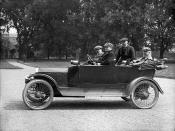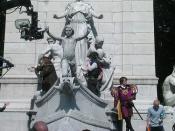In the text article, "Childhood's End", a journalist describes his visit to Northern Uganda. (Hitchens, 2006) The purpose of his visit was to gather information about the notorious "Lord's Resistance Army", which is lead by a middle-aged man named Joseph Kony. For nineteen years, Joseph Kony has been terrorizing Ugandan villages in order to enslave children in his army. Many of these children are forced to become soldiers who then continue the onslaught of murder, rape and torture throughout Uganda. When travelling through Uganda, Christopher Hitchens was able to talk to local children either in rehab centers or in their villages. One child shared with him his experience of being attacked by the Lord's Resistance Army while he was at home with his four brothers. The boy described the most brutal and violent details of the attack, which involved torture, death and enslavement of his many boys in his village.
The trauma and bloodshed that approximately 250 000 child soldiers worldwide are experiencing has resulted in researchers conducting studies on the impact these traumatic events has on the development of a child. What follows, is a discussion of PTSD among former child soldiers and examples of treatment methods being offered to children who have experienced war trauma through enslavement, torture or murder.
In his magazine article describing the obscene violence that is currently going on in Uganda, Christopher Hitchens sits down with a boy named James at a rehab center. James was fortunate enough to escape being a slave to Kony, when he was marched all the way to Sudan, where an ambush ensued and James got away. Marching long distances was an initiation technique used by the Lord's Resistance Army in order to herd out the weaker boys. If a boy was too tired to go on,


